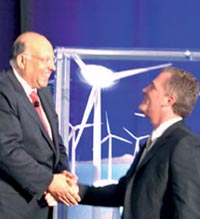FLANAGAN -
GRID CHALLENGE MET MILAN, IT - On a count of 3-2-1, Paul Browning,
CEO of GE Thermal Products and Dr. Celel Metin,
CEO of MetCap Energy investments unveiled the
FLEXEfficiency 50 combined cycle plant model. |
Paul Browning (r)with Dr. Celel Metin in front |
| The FLEXEfficiency 50 plant creates an immense growth opportunity in a new segment for our gas turbine technology and is in lock-step with our commitment to build a cleaner energy future,” said Paul Browning. GE invested over $500 million in research and development to deliver the 510 megawatt plant offering fuel efficiency greater than 61 percent with a 10 percent smaller footprint. It will reduce annual CO² emissions by more than 12,700 metric tons and also avoids 10 metric tons of NOX annually. Under typical operating conditions of 4,500 hours, cost savings of $2.6 million could be realized. It will ramp-up at a rate of more than 50 megawatts a minute, doubling present day rates and is in response to fluctuations in wind and solar power. GE announced a $170 million investment in a first-of-its-kind full speed, full load test facility in Greenville, SC that will provide factory validation of its new technology. “With global energy demand expected to double by 2030 and electricity generation accounting for 40 percent of greenhouse gas emissions, utilities and government bodies are taking a hard look at how to produce power more efficiently,” said Ricardo Cordoba, president of GE Energy for Western Europe and North Africa. “This innovation can have a dramatic effect on CO² emissions and offers a nimble, efficient and cost-effective way for us to help E.U. countries in pursuit of 20-20-20 energy goals.” The power plant will be located in
Karaman, Turkey and scheduled to
enter commercial operation in 2015.
The engineering, procurement and construction
services will be provided by
Gama Power Systems Engineering and
Contracting.
“We are very excited to partner with GE,” said John Van Scoter, CEO and president of eSolar. “Combining our solar solutions with GE’s thermal power experience and large plant expertise creates a more environmentally responsible power generation solution for power producers worldwide”. eSolar’s power plant technology uses small, flat, pre-fabricated mirrors called heliostats to track the sun and reflect its heat to a tower-mounted receiver. This generates steam used by the plant’s power block to create electricity. Thousands of heliostats are aligned and controlled using advanced software algorithms to precisely focus the sun’s energy. eSolar’s technology is architected to provide modular fields that maximize energy production, and are scalable to meet a wide range of customers’ power deployment. eSolar was founded in 2007 to develop modular and scalable solar thermal power plant technology. The eSolar solution marries a low-impact, pre-fabricated form factor with advanced computer software engineering to meet the demand for reliable and post-competitive solar energy. eSolar is based in Burbank, CA. The FlexEfficiency 50 plant is the first product in GE’s new FlexEfficiency portfolio and part of GE’s ecomagination commitment to drive clean energy technology through innovation and R&D investment. The launch follows GE’s recent announcements of the world’s most efficient wind turbine, the highest reported efficiency for thin film solar and $11 billion in acquisitions that strengthen a portfolio supporting natural gas and power transmission. |
|
|
|
|
|
|

